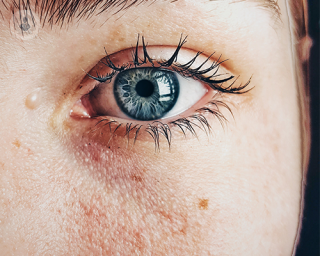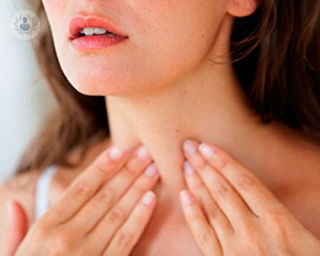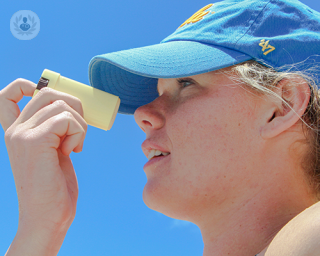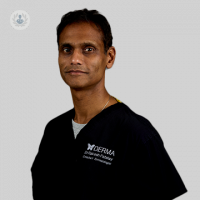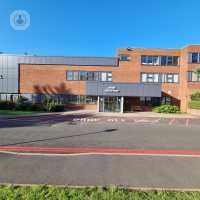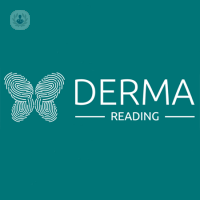Basal cell carcinoma
Mr George Christopoulos - Plastic surgery
Created on: 03-01-2017
Updated on: 10-25-2023
Edited by: Jay Staniland
What is basal cell carcinoma?
Basal cell carcinoma (also known as basal cell cancer) affects the cells of the lower layer of the epidermis. It is the most common type of skin cancer and it mostly appears on areas of the skin that have had a lot of sun exposure, mainly being the face and neck. In almost all cases, it grows and develops slowly.
Once diagnosed, basal cell carcinoma is treated by a specialist dermatologist.

What is the prognosis?
As with many other types of cancer, basal cell carcinoma is a serious disease that requires prompt treatment. If left untreated, the skin cancer can lead to metastasis, which means it can spread to other areas of the body and affect other tissues, bones and organs.
Due to it being a type of cancer that typically grows very slowly, it has a good prognosis for being fully cured when diagnosed early.
What are the associated symptoms?
A slow-growing carcinoma might not have any symptoms for a long time. When symptoms show, they can appear as different marks on the skin, and will typically include the following:
- a bump on the skin
- an area of skin that is pearly, waxy, very pale, and/or pink or brown in colour
- a flaky and red patch of skin
- a persistent sore or scar
What medical tests are carried out when testing for basal cell carcinoma?
A dermatologist will perform a physical exam to look at the areas suspected for carcinoma. To determine the diagnosis, a skin biopsy will be performed. This consists of extracting a sample of affected skin in order to effectively analyse its cells in a laboratory.
What are the main causes of basal cell carcinoma?
Most basal cell carcinomas occur from exposure to the sun, in areas that have been exposed to sunlight, or other types of ultraviolet radiation. It usually occurs from middle age, due to the accumulation of sun damage to the skin, but it can also appear in young people who have overexposed their skin to the sun.
Can it be prevented? If so, how?
Basal cell carcinoma can be prevented by avoiding excessive sun exposure, sunburns, and ultraviolet radiation. Using sun cream with a high enough SPF (sun protection factor) is essential to reduce sun damage.
Early diagnosis can prevent the cancer from developing, and so, it is very much recommended to have an annual dermatological exam. In this exam, pigmented scars and their development are monitored.
What are the different treatment options for basal cell carcinoma?
The treatment of carcinoma will depend on its location and stage. It can be treated both surgically and non-surgically. The surgical options include the following:
- Surgical excision: the surgeon removes the entire area affected by the carcinoma and a slight margin of surrounding healthy skin. They then use stitches to re-join the skin.
- Mohs surgery: the removal of the affected layers of skin.
There are also various different non-surgical options when it comes to treating basal cell carcinoma. They include:
- Curettage and electrodesiccation : the cancer cells are scraped off the skin using a curette, and then electrodesiccation destroys the remaining cancerous cells via intense heat.
- Cryosurgery: the cancer cells are frozen to destroy the tumour. It can then blister and fall off.
- Topical treatments: creams are applied to the area affected by BCC.
- Photodynamic therapy: photosensitising cream is applied to the skin and on the tumour, and then the area is irradiated with a dose of light.
- Radiation: X-ray beams destroy the tumour.
- Chemotherapy: this may be necessary in cases of cancer that has spread to other parts of the body.
Which specialist treats it?
A dermatologist can diagnose and treat basal cell carcinoma. Depending on the degree and progression of the disease, the patient may require radiotherapy or chemotherapy treatment with an oncologist.
What are the main risk factors?
There are certain risk factors that increase an individual's chances of suffering from this type of skin cancer. You are at a higher risk of suffering from this type of skin cancer if you:
- regularly engage in indoor tanning
- get too much UV sun exposure
- are over the age of 50
- have previously had skin cancer, such as melanoma
- have fair skin
- are male
- have chronic infections
- have suffered skin inflammations as a result of burns or scars
People who meet or have several of the following characteristics are more likely to develop basal cell carcinoma:
- very pale, freckled skin
- blond or red hair
- light eyes - blue or green
- family history of skin cancer
- multiple sunburns
- high level of sun exposure
- smokers
- a weak immune system
Also, if your job requires that you spend quite a significant amount of time outdoors, your risk of developing basal cell carcinoma increases.

How can I take care of myself and my skin in the sun?
It is advised that people who have fair skin and who are over the age of 50 ensure that they try to stay in the shade when the sun is at its strongest, which is typically from roughly 11am to 3pm. It is also highly recommended to avoid getting burnt by the sun as much as you possibly can, so applying suitable sun cream regularly is a must.
Other effective things people can do to properly take care of their skin whilst in the sun include wearing UV-protective sunglasses, wearing light, cool clothing, and wearing wide-brimmed hats.
Can basal cell carcinoma spread to other parts of the body?
Yes, although it is quite rare. When this rarity occurs, the cancer typically spreads to nearby lymph nodes. Targeted drug therapy and chemotherapy are the two main means of treatment for basal cell carcinoma that spreads.
What does basal cell carcinoma look like on white skin?
Its appearance on individuals with white skin generally looks like either a skin-coloured or pink bump.
What does basal cell carcinoma look like on black skin?
The appearance of basal cell carcinoma on black skin differs to the appearance on white skin. In individuals with black skin, basal cell carcinoma will typically look like either a brown or glossy black bump that has a rolled border.

